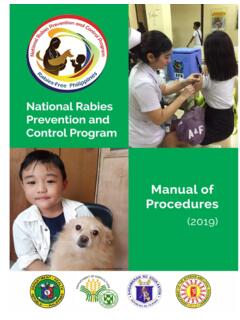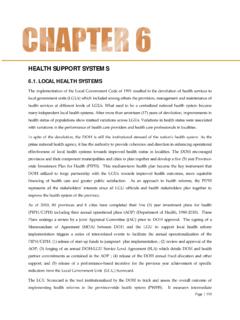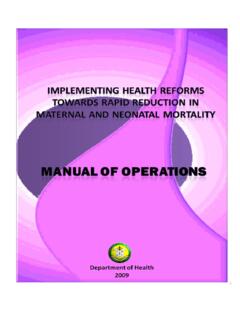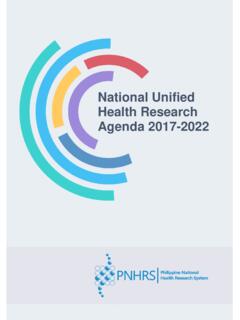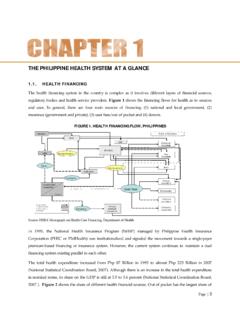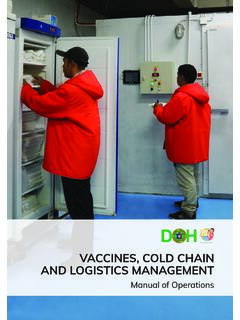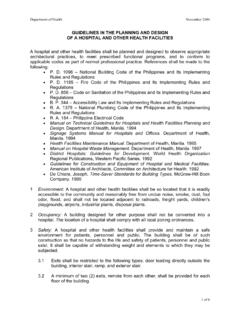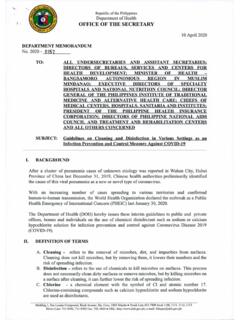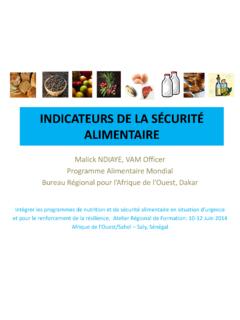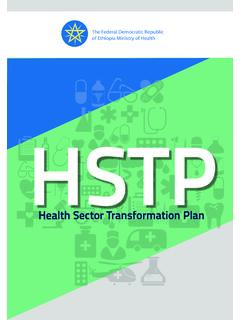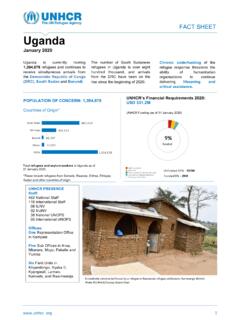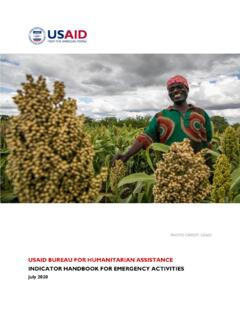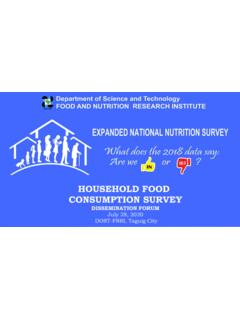Transcription of 2019-2023 Food and Water-Borne Disease Prevention and ...
1 1 2019-2023 Food and Water-Borne Disease Prevention and Control Program (FWBD-PCP) Strategic Plan 2 Contents Foreword 3 Acknowledgement 4 Acronyms 5 Part 1 Introduction 7 I. Background 8 II. The Philippine Profile 9 III. The Philippine Health System 10 IV. Milestones in FWBD-PCP Development and Implementation 12 Part 2 Assessment of the FWBD PCP Implementation Status 13 I. Assessment Objectives 14 II. Assessment Methodology 14 III. Assessment Parameters 15 I. Assessment of FWBD-PCP Performance Levels 17 A.
2 Overall Performance B. Morbidity and Mortality Rates By Specific Food and Water-Borne Diseases Diarrhea 18 Cholera and Typhoid Other Food and Water-Borne Diseases 19 FWBDs by Sex FWBDs by Age Group FWBDs by Geographical Areas C. Outbreaks Due to FWBDs 21 D. Implementation Status of Proposed Strategies for 2011-2016 22 E. Influencing Factors 23 F. Summary of Gaps and Challenges 27 G. Recommendations 29 Part 3 2019-2023 FWBD- PCP Strategic Plan A. Vision, Mission, Goal, Objectives and Strategies 32 B. FWBD-PCP Key Targets 34 C.
3 Budgetary Estimates 36 D. Implementation Arrangements 36 E. Roles and Functions of Key Players 37 ANNEXES Annex 1. Annual Performance Targets and Indicative Action Points 45 Annex 2. Budget Estimates to Execute the 2019-2023 FWBD-PCP Strategic Plan 68 Annex 3. Budgetary Estimates to Execute 2019-2023 FWBD-PCP Strategic Plan 69 Annex 4. List of People Consulted in the Assessment and Plan Development 102 3 Foreword Food and waterborne diseases (FWBD) are among the most common cause of diarrhea which remain one of the ten leading causes of morbidity and mortality in the country.
4 Also, outbreaks from FWBD can be very massive and catastrophic. Since most of these diseases have no specific treatment modalities, the best approach to limit economic losses due to FWBD is Prevention through health education and strict food and water sanitation. In 1997, the Department of Health (DOH) issued AO No. 29-A s. 1997 Creation of the Food and Waterborne Diseases Prevention and Control Program which defines the roles and responsibilities of different agencies to ensure Prevention and control of Food and Waterborne Diseases.
5 The goal of Food and Water-Borne Diseases Prevention and Control Program is to reduce the morbidity rate and eliminate deaths due to diarrhea. The program also aims to reduce the number of all typhoid, paratyphoid, and cholera outbreaks to one percent or one per 100,000 populations annually. Since the occurrence of food and Water-Borne diseases is essentially related to economic and socio-cultural factors, the program recognizes that outbreaks will persist unless underlying social ills are corrected. Along with poverty comes the prevalence of infectious diseases.
6 However, if specific interventions are employed, a drastic reduction of bacterial and parasitic infections can also be expected. The Food and Waterborne Disease Prevention and Control Program 2019-2023 Strategic Plan supports the medium term strategic framework for 2019-2023 indicated in the Administrative Order 2018-0014 entitled Strategic Framework and Implementing Guidelines for FOUR mula Plus (F1+) for Health. F1+ for Health expands the four pillars of health reforms (financing, service delivery, regulation and governance) and highlights greater focus on performance accountability towards the Filipino people.
7 Following F1+ for Health, the implementation of the strategic plan also focuses on sustainable, manageable, and critical interventions for food and waterborne Disease Prevention and control. 4 Acknowledgement This undertaking is a product of collaboration of many individuals from different institutions committed to address food and waterborne diseases in the country. These individuals shared their time, energy and expertise in the preparation of this strategic plan: The FWBD Program Advisers, Lyndon Lee Suy, MD, MPH; Mario Baquilod, MD, MPH, CESO IV, Leda Hernandez, MD, MPH; The Division Chiefs, Rosalind Vianzon, MD, MPH and Franklin Diza, MD, MPH; The Program Manager, Theodora Cecile Magturo, MD, MHA; The consultant, Ms.
8 Eireen Villa; The staff, Ms. Rae Hanna Guiaber, RN, Ms. Marvie Porcioncula, RN, and Mr. Eric Ericzon Elairon. The stakeholders consulted during the field validation visits, TWG meetings, and Expanded Consultation and Planning Workshops, who also actively participated during the planning process (see Annex 4 for the complete list). 5 Acronyms ABD Acute bloody diarrhea AWD Acute watery diarrhea ARMM Autonomous Region of Muslim Mindanao BHS Barangay Health Stations BAI Bureau of Animal Industry BFAR Bureau of Fisheries and Aquatic Resources CPG Clinic Practice Guidelines CARI Control of Acute Respiratory Illnesses CDD Control of Diarrheal Diseases DA Department of Agriculture DOH Department of Health DALY Disability Adjusted Life Years EB Epidemiology Bureau ESR Event-Based Surveillance and Response FHSIS Field Health System
9 Surveillance FDA Food and Drug Administration FWBDs Food and Water-Borne Diseases FWBD-PCP Food & Waterborne Disease Prevention & Control Program GIDAs Geographically Isolated and Depressed Areas GHO Global Health Observatory HSRA Health Sector Reform Agenda HH Households iycf Infant Young Child Feeding IDO Infectious Disease Office IMCI Integrated Management of Childhood Illnesses IACHE Inter-agency Committee for Environmental Health IPCC Inter-Personal Communication and Counseling LGC Local Government Code LGUs Local Government Units MHCs Main Health Centers NDHS National Demographic Health Survey NHTS National Household Targeting System NMIS National Meat Inspection Services NOH National Objectives for Health NBB No Balance Billing NCDs Non-Communicable Diseases ORT Oral Rehydration Therapy PSP Paralytic Shellfish Poisoning PHA Philippine Health Agenda PIDSR Philippine Integrated Surveillance and Response RDT Rapid Diagnostic Test RITM Research Institute for Tropical Medicine RPRH Responsible Parenthood and
10 Reproductive Health RHUs Rural Health Units SI Sanitary Inspector SDGs Sustainable Development Goals TWG Technical Working Group UHC Universal Health Care WINS WASH in Schools WASH Water, Sanitation and Hygiene WHO World Health Organization 6 Part 1 Introduction It has been estimated that million people worldwide die each year as a result of diarrheal diseases, most of which can be attributed to contaminated food or water. The occurrence of food and Water-Borne diseases (FWBDs) remains a significant health issue in both developed and developing countries.
